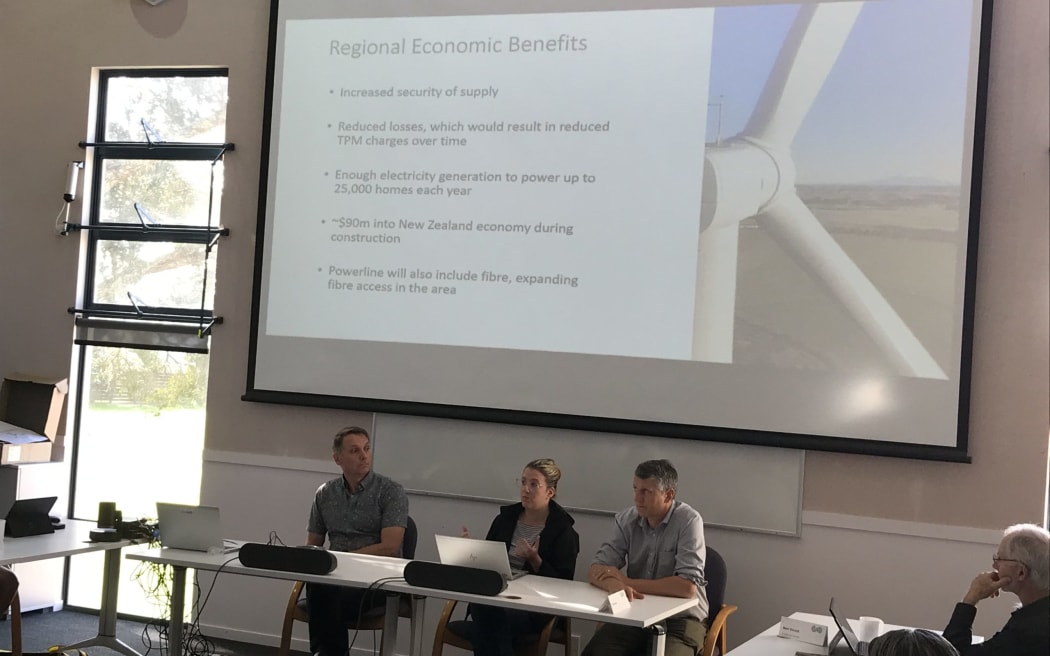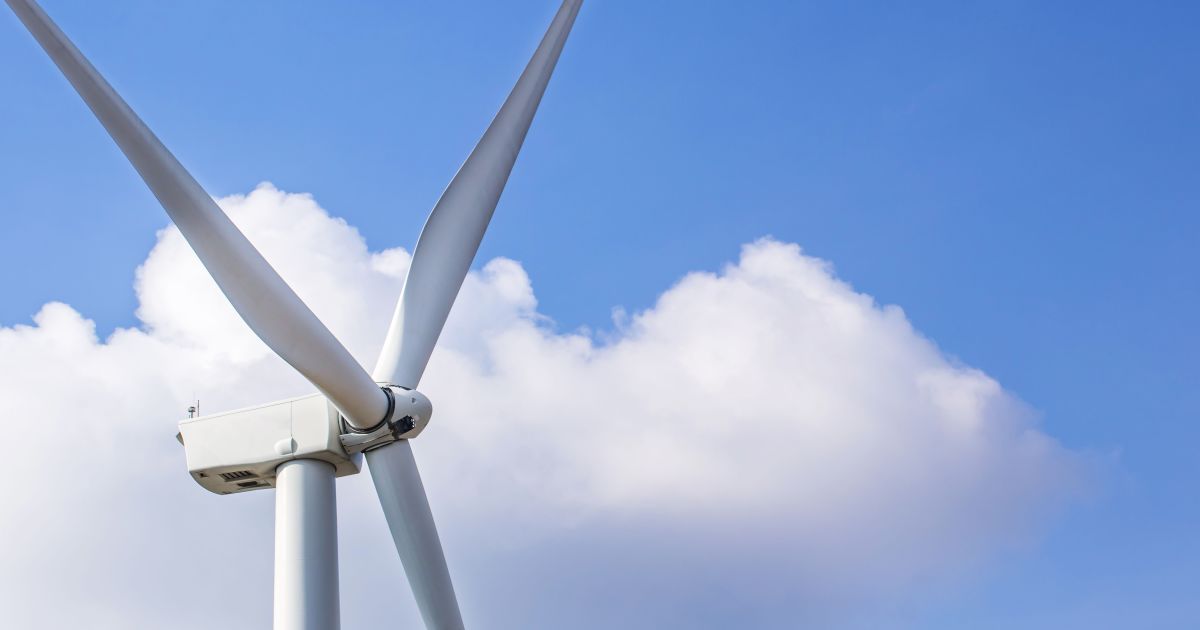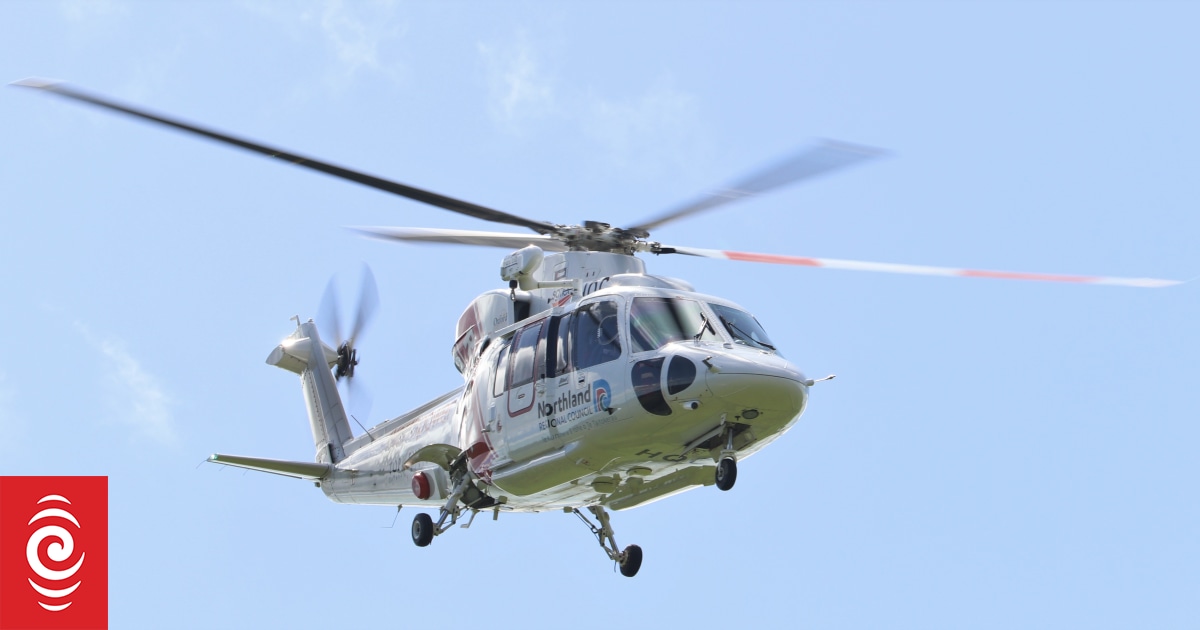
The regional economic benefits of the new Kaiwaikawe Wind Farm are highlighted on a projection at a Kaipara District Council meeting in Dargaville.
Photo: LDR / Susan Botting
New Zealand energy generator Mercury’s $200 million Kaiwaikawe Wind Farm has moved a step closer after Kaipara District Council’s (KDC) lukewarm approval for high voltage overhead power lines along part of its major new Northland tourist rail trail.
The high voltage lines – which one councillor was worried could buzz and swing in the wind above trail users – are to be strung on 15 metre-high power poles along a 1.8 kilometre-long easement on Northland’s new $10 million Kaihu Valley Trail.
KDC, at its last current-term council meeting in Dargaville on Wednesday, voted in a lukewarm decision, to allow Mercury subsidiary Tararua Wind Power Limited (TWP) a 12.5m-wide easement for the 66 kilovolt overhead lines stretching the equivalent of 18 end-to-end rugby fields along the trail.

Outgoing KDC councillor and former Kaipara acting mayor Peter Wethey said he was concerned about 1.8km of the trail being in the shadow of the 66kV power line, warning of its negative impact for some trail users in comparison with other Northland rail trails.
Wethey expressed concern at last month’s KDC council meeting in Mangawhai about the overhead power lines buzzing and swinging in the wind above trail users.
He asked Mercury representatives at the Dargaville meeting whether overhead power lines of this nature had been put up along any other New Zealand cycle and walking trails.
Mercury Kaiwaikawe Wind Farm project leader Jim Pearson said after the meeting he was unsure what was happening in that sense on other New Zealand rail trails.
The TWP-constructed and Northpower owned-and-operated high voltage power lines are part of the infrastructure connecting Mercury subsidiary Tararua Wind Power Limited’s Kaiwaikawe Wind Farm at Omamari into the national electricity grid at Dargaville. There will be four lines – three 66kV power conductors and one fibre optic cable – carried on 25 power poles along the trail easement.
Kaiwaikawe is one of New Zealand’s furthest progressed in-the-making wind farms and Northland’s first.
Kaihu Valley Trail has been identified as Northland’s highest-priority new rail trail. It runs between Dargaville and Donnellys Crossing and is being developed by KDC with the help of $4m in government funding. Construction started this year.
The trail follows an old railway line which was started in 1883 to enable the export of kauri via Kaipara Harbour. It will eventually become one of almost two dozen New Zealand Great Rides – as part of the Ancient Kauri Trail from Kaipara’s Maungaturoto to Omapere in Hokianga.
Just over half of KDC’s nine elected representatives voted in Wednesday’s 3:2 decision in favour of the easement.
Kaipara Mayor Dr Jason Smith and councillors Karen Joyce-Paki and Mark Vincent voted in its favour, in a one-person majority vote over councillors Victoria del la Varis-Woodcock and Johnathan Larsen, who voted against. Deputy Mayor Anna Curnow, Peter Wethey, David Wills and Eryn Wilson-Collins abstained from voting.
Kaiwaikawe is about 12km north-west of Dargaville. The medium-sized wind farm will have up to nineteen 220m-high wind turbines.
It will cost $200m to build. Pearson said $90m of that would be of direct economic benefit to Northland, about half of that to Kaipara.
Construction is expected to start in mid-2023 with power generation from the end of 2024.
The wind farm is expected to generate about 230 gigawatt hours (GWh) of energy annually. Genesis Energy has a 20-year agreement to buy the wind farm’s power for further sale.
Councillor Wilson-Collins said she was conflicted about the new infrastructure.
“I am extremely conflicted. I love the wind farm sustainability and having it in Northland. This is a solution that Northland needs. I really support the wind farm, but I am really concerned about the trail,” Wilson-Collins said.
Mercury subsidiary Tararua Wind Power Limited has offered $40,000 compensation to KDC for any potential loss to tourism from the overhead high voltage lines’ presence. The trail easement is from Babylon Coast Road to Parore West Road.
Another $40,000 has also been offered for trail promotion and sponsorship.
Wilson-Collins said the combined amount proferred was not large.
“$80,000 for an in-perpetuity easement is not too exciting for what we may be giving up,” she said.
Northland this year became New Zealand’s first renewable energy zone. Kaiwaikawe is Northland’s first and one of New Zealand’s furthest-progressed new wind farms.
Mayor Smith said 1.8km was only a tiny portion of the Kaihu Valley Trail’s 45km length and took just two minutes to traverse by e-bike.
Several councillors were interested in the power lines being put underground rather than overhead.
Deputy Mayor Curnow said this would save a lot of problems.
Northpower contracts and services manager Alan Rawson said locally-produced Northland power had become even more important in the wake of new national legislation which would see the North paying more than other regions because of its distance from where the power it used was generated.
Mercury Kaiwaikawe Wind Farm project leader Stephanie Cook said the new wind farm would mean Northland was able to locally produce more than 50 percent of its own power. This would be up from the current 34 percent via Ngawha power station.
She said the new windfarm’s production would provide power for 25,000 houses annually and save the production of 170,000 tonnes of CO2 from power otherwise generated via coal.
Kaiwaikawe was formerly called Omamari Wind Farm but has been renamed in conjunction with local Iwi Te Roroa.
Local Democracy Reporting is Public Interest Journalism funded through NZ On Air.




